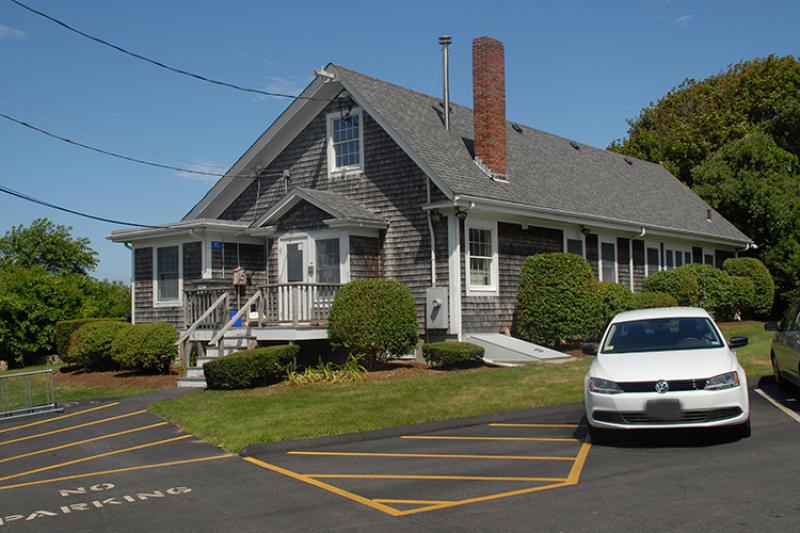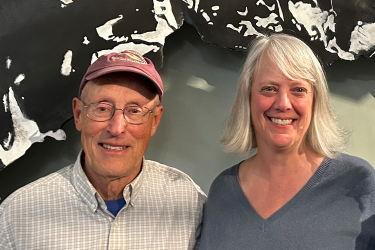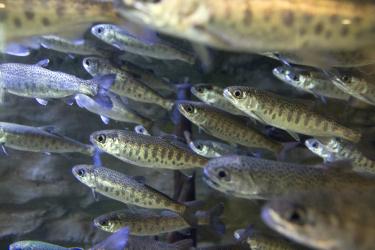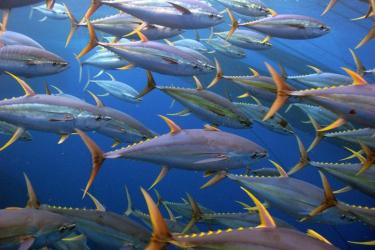With weathered natural cedar shingles, white trim, and a small lawn, the cottage by the sea on Great Harbor in Woods Hole is a typical Cape Cod-style building. Many passing by on Albatross Street might assume it is a private residence.
But a few things stand out. A large parking lot fills most of the front “yard.” Next door is the town dock and boat landing. On the other side of the landing is the Woods Hole Science Aquarium. This cottage has an interesting history, and the outward appearance belies what lies inside—a research lab that ages fish!
Ten scientists work here. They are part of the Northeast Fisheries Science Center’s Population Biology Branch. Inside, their lab still resembles a home, with staff using what would be the bedrooms and living area of the house as offices and work spaces. The former kitchen houses two special saws used to cut thin sections of fish earbones and a large specialized microscope to view the samples to determine the age of the fish it came from.
Many of these scientists go to sea on the annual spring and autumn bottom trawl surveys, and are busy year-round aging samples from fish caught on the survey as well as samples from commercial fish landings and other sources. It’s a busy place doing important work, but still a “home” of sorts to those working here.
A Unique History
During World War II, the Woods Hole Lab was closed and occupied by the U.S. Navy, although a small cadre of federal fishery scientists continued to work in other locations around the village. A mess hall for sailors on the Coast Guard ships, when in port, stood on the northern part of the fisheries property. The Navy transformed this structure into a small hospital and dispensary. Next to it they built a wooden barrack as living quarters for WAVES—Women Accepted for Volunteer Emergency Service—the Navy’s reserve unit for female members established on July 30, 1942.
The barrack was not occupied when the Navy returned the property to the Fish and Wildlife Service, then the parent agency for the Bureau of Fisheries, now NOAA Fisheries. The hospital building and WAVES quarters were rebuilt as apartments, which in the following years were reportedly occupied by the director and the administrative officer of the station. Who actually lived there following the war remains unknown and may yet be found in records we have not come across. Most of us have always known it as a research lab rather than a residence.
Visible Changes After World War II
Repurposing the War-Era Buildings
The 1885 residence, lab building, and other structures at the end of Water Street were demolished in 1958. The wartime-era buildings nearby had to be moved as plans were finalized for construction of the current main lab and aquarium on the same site. In 1957, the federal government gave the long wood-frame building to the Marine Biological Laboratory. This is the one previously used as a mess hall, hospital, and then quarters. The building was cut in half and moved several miles away to F.R. Lillie Road, where the two halves became two private residences that are still there today.
The WAVES quarters, which became known as the director’s residence, was also moved and repositioned on a new site nearby, previously used as a parking lot. Now called “the cottage”, it sits on the other side of the town dock and boat landing.
The cottage address officially is 32 Bar Neck Road, rather than Albatross Street as might be expected. It sits on an odd-shaped parcel of government-owned land that only has frontage on the harbor and on Bar Neck Road.
Later Land Deals Support a Town Dock and Local Yacht Club
Land was donated and deeded to the government to construct the first permanent laboratory facilities in the 1880s. Subsequently, a few issues were discovered that needed resolution. As Paul Galtsoff noted in his 1962 history of the Woods Hole Laboratory: “A lack of clarity in the original title and informal agreements made by Baird with the selectmen of the Town of Falmouth” resulted in some confusion over title to the property.
For example, in the 1950s the Town of Falmouth and the federal government agreed to exchange equivalent amounts of land, each about 40 feet wide, on Water Street and Albatross Street. That way, the Town of Falmouth had a place to construct a town wharf and public landing on Albatross Street on Great Harbor. This split the government property into several parcels on the waterfront, one being the Bar Neck Road property containing the cottage.
Government property also originally included the land now occupied by the Woods Hole Yacht Club, which rented the property from the government for many years. Then, in 1958, the roughly one-acre property was declared surplus. In 1961, the yacht club bought the land for $6,000 with the provisions that it be used for specific purposes and returned to the government if those provisions were not met and the yacht club no longer existed.
For more information, please contact Shelley Dawicki.







